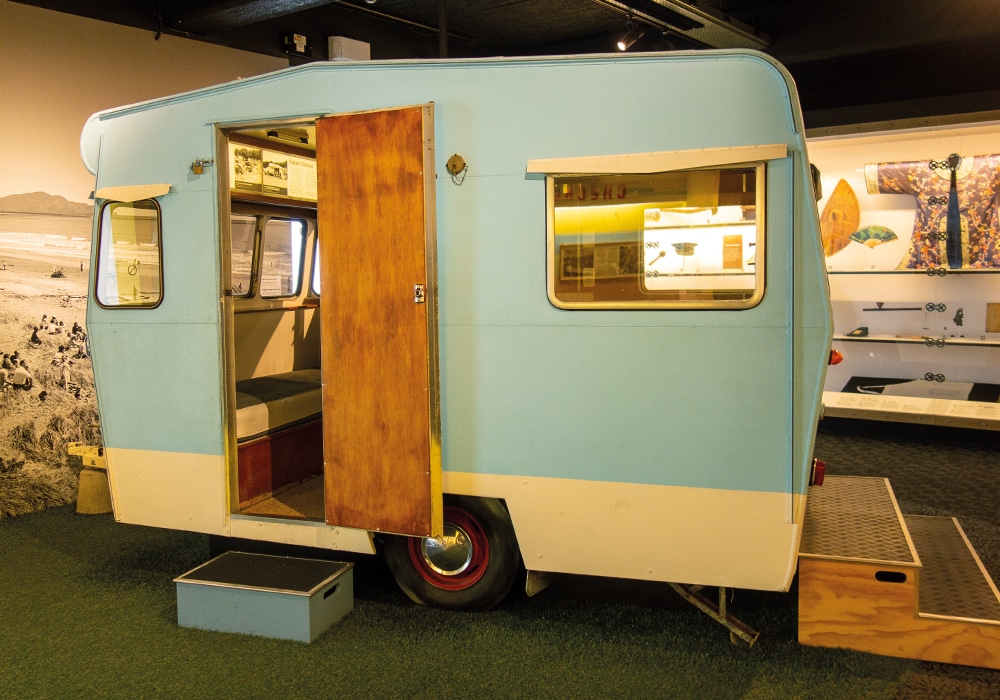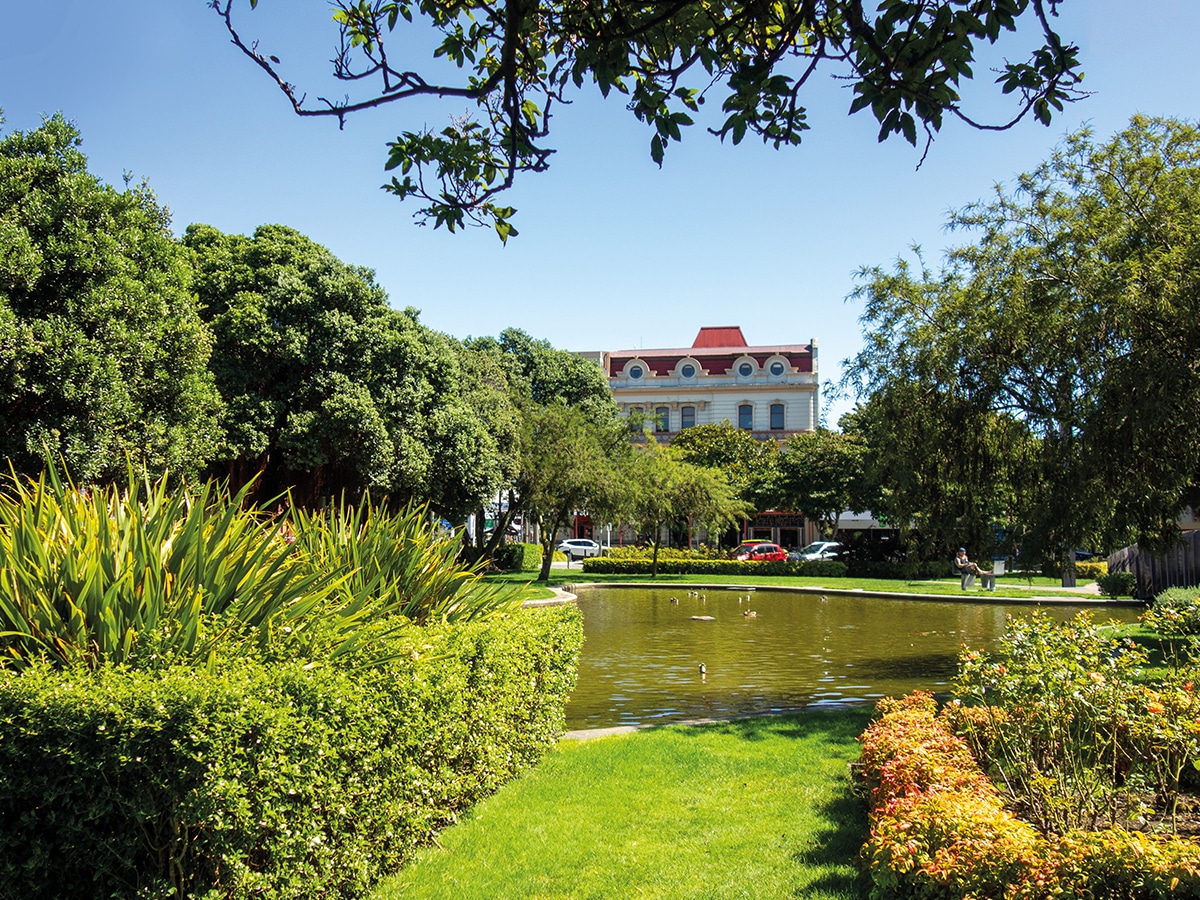Paul Owen finds some historic camping treasures right in the middle of the North Island.
In the centre of the museum, in the centre of Palmerston North, that balmy city with the good fortune to be located near the centre of New Zealand, you’ll find an exhibit that’s central to the pastime of caravanning in this country. It’s a well-travelled example of an Explorer caravan chocked full of Kiwiana that confirms its date of manufacture – 1964.
Explorer Caravans were as iconic as the Edmunds cookbook at the time of Beatlemania and were exported from the city to dealerships as far away as Hawke’s Bay and Taranaki. Which meant that if you ever pulled into a motor camp located anywhere in the southern North Island during the era that ‘Love Me Do’ was being played on the radio, you were likely to find it packed with Explorers. It certainly helped the popularity of the Explorer that the caravan could be towed behind vehicles as humble as Morris Oxfords and the earliest Holdens.
Another big selling point was the tubular steel frame at a time when most caravans were made of wood. Buyers knew that an Explorer would hold itself together on the journey down the rugged dirt road to Castlereagh beach for the annual horse races, or even what was then a gravel road leading from Palmy to Vinegar Hill, some 50km to the north. The latter remains a popular council-maintained freedom camping site on the banks of the Rangitīkei River. If you’re visiting Palmerston North from any points further north, a stop over at Vinegar Hill, whether for a picnic or for a night or two, is a great way to recharge the human batteries before entering the bustling, busy city that is the economic heart of the Manawatū.

Cubist square
Being sited on a flat river terrace gave Palmerston North’s original planners the opportunity to lay the city out with a grid-like pattern of streets. At the centre of the grid, you’ll find the green heart of the berg – a place known by most locals as ‘The Square’. It’s a park-like space that doesn’t quite escape the bustle as there’s some well-trafficked city thoroughfares surrounding it. ‘The Square’ is therefore the closest thing in New Zealand to Central Park in New York. You can admire the nature, the sculptures, and the historical markers of the amenity, but a strident soundtrack of traffic noise, amplified by the multi-story buildings on all sides, constantly reminds that you’re in the heart of an increasingly busy city.
‘The Square’ has a three-dimensional nature because of the surrounding buildings, so much so that I’m tempted to call it ‘The Cube’. A far better option, I think, is to revert to its original name – Te Marae o Hine – the courtyard of the daughter of peace. This is what Rangitāne iwi called the land long before they gifted it to the city to become a meeting place of all races in the name of peace.
Not that some of the surrounding architecture has been built in a similar spirit of sharing and cooperation. One multi-story structure invades the park like it owns it, bridging over one of the ring roads to claim space that was originally reserved for recreation rather than business. It’s the Palmerston North City Council building, sending developers an encouraging message about what constitutes appropriate urban planning. It says ‘look, we approved this, so we’ll probably approve anything’.
The council building, which opened in 1980, is one of the finest examples of ‘brutalist architecture’ in New Zealand, and it’s well worth taking a wander around the marae just to celebrate or criticise its Stalinist projection of power. You’ll find the PNCC more than makes amends further along the same street with the City Library. It retains the original art-deco façade of the Direct Importers Company (DIC) building c1920, ushering bookhounds through a beautifully executed glass atrium.

Amazingly, neither the PNCC building nor the City Library comply with current earthquake standards. Will Palmy locals miss both The Beauty and The Brute if they’re knocked down? Despite Te Marae o Hine giving up some of its real estate to create more car parks over the years, and the constant parade of look-at-me combustion engines, this is still a place where calm reflection and contemplation are possible. There’s some impressive art on display between the colourful flower beds, the water features, and the tree-fringed pathways. As Rangitāne originally wished, it’s a multicultural display. There’s Maori pou mixing with Pasifika stone sculptures, a moving war memorial statue and roll call of the fallen in bronze, the poignant ‘Ghost of the Huia’ by Paul Dibble, and the Hopwood clock tower that was erected in 2008 but looks appropriately art deco to match most of the surrounding architecture. There’s also a statue in white marble of the Rangitāne Rangatira who made Palmerston North possible.
Palmy’s peacemaker
The statue of Te Peeti Te Awe Awe was erected by his descendants in 1907 to honour the peace that he won for Rangitāne through his encouragement of European settlement in the Manawatū. Te Peeti was born in one of the most turbulent and bloodiest periods of Māori history – the 1820s. He therefore witnessed firsthand the violence of the inter-tribal Musket Wars and the displacement they caused of well-armed tribes from the Waikato and Taranaki and their migration southwards to contest Rangitāne’s ownership of land. He was particularly concerned by the constant attempts of incoming Ngāti Raukawa and Ngāti Kauwhata to enslave or displace his Rangitāne hapu, Ngāti Hineaute and Ngāi Tamawahine, and took an active role in the leadership of these hapus after his grandfather and uncle were killed in battles with the invaders.

In 1863 Te Peeti successfully obtained official recognition of the ownership of 240,000 acres of the Rangitīkei – Manawatū block for his hapu and neighbouring Ngāti Apa from the government. He then negotiated the sale of much of this land back to the government and subsequently played a major role in the sale of a further 250,000 acres of Rangitāne land in the Palmerston North block to the crown.
With these sales kicking off the building of a successful rural economy for the Manawatū district, the foundations for a city located at its centre could be laid.

Heart of the city
Te Peeti is also remembered by the information boards that greet visitors entering Te Manawa, the city’s museum of art and home of the Explorer caravan, located a block away from Te Marae o Hine. On the way in you get to pass two other important markers of the city’s past.
The first is Totaranui, a restored settler’s home dating back to 1875. It was the 19th Century home of sawmill owner, Peter Manson, and the sawmill was sited on the same land as the museum. As Manson’s workers cleared the mature Totara Forest that carpeted the land the city was eventually built upon, it created Papaoiea Clearing in the city suburb of Terrace End, the original site of the dwelling. Moved and restored to as-new condition at its present site in 1970, Totaranui opens a window to 19th Century housing construction through its choice of materials. The window frames, architraves, doors, and skirting boards were crafted from Northland Kauri, which traveled by ship to Foxton, and onwards by train to Palmerston North. The original roof was made of Kahikatea shingles, while the chimney bricks bear the name of Charles Tricklebank, Palmerston North’s first brickmaker.

The rest of the timber was milled from the large Totara trees that used to inhabit Terrace End. To get an idea of the impressive size of the trees that used block out the sun on the site of the city, it’s worth visiting the spectacular Pohangina Totara Reserve, located 20km northeast of Palmerston North. The second is the statue of Charles Monro, the man who introduced rugby to New Zealand when he returned to the country as a 19-year-old after a three-year stretch at Christ’s College in North London and convinced the Nelson Football Club to adopt the rules of Rugby School. The year was 1870, and the first game that the club played against Nelson College lit the fires of what is now a national obsession.

The New Zealand Rugby Football Union was formed in 1892, four years after Monro made Palmerston North his home until his death in 1933. The Monro statue, unveiled in 2011, sets the mood for rugby fans as they’re about to enter the Rugby Museum located on the second floor of Te Manawa. The Rugby Museum was named by Trip Advisor as the city’s greatest attraction.
Native bird haven
To a native bird-lover like me, that honour belongs to the Wild Base Recovery Centre, a native bird aviary and rehabilitation centre located in the city’s extensive bush- and park-lands alongside the Manawatu River. A joint venture between PNCC and Massey University, sponsored by the Central Energy Trust, the Wild Base Centre calls upon the skills of the university’s vets to heal native birds that are sent from all over the lower North Island.
You can check what patients are being treated at the centre by checking out the centre’s website, wildbaserecovery.co.nz/ before your visit. The usual suspects include the kererū (clumsy fliers), ruru (susceptible to cat predation), and kārearea (attracted to roadkill). Permanent residents at the centre include tuatara, red crowned kākāriki, whio, pāteke (brown teal), korimako (bellbird), and kākā. Entry to the centre is free; keep in mind that it is closed on Mondays.
If you have turned up at the centre on the wrong day, the second prize is a stroll along the bush-lined banks of the Manawatū River. The once-lush native forest is rapidly regenerating in this part of the city, and you’re likely to spot many of the birds that you might have sought by visiting the centre living wild and free in the tree canopy.

Other attractions along the river’s banks include playgrounds, minigolf, miniature train rides, and the well-tended Dugald MacKenzie Rose Gardens. There are thousands of blooms in the latter, displaying the full spectrum of colour, and a stroll or a bike ride along the river is a great way to escape the bustle of the northern and central suburbs of the city, and enjoy the peace that Te Marae o Hine once provided.

Where to stay
• Palmerston North Holiday Park is a family-run campground situated on 4.5 hectares of peaceful parkland behind the Aquatic Centre. palmerstonnorthholidaypark.co.nz/
• For more on Vinegar Hill, visit www.mdc.govt.nz/services/parks-and-public-spaces/camping-grounds/putai-ngahere-domain-vinegar-hill








